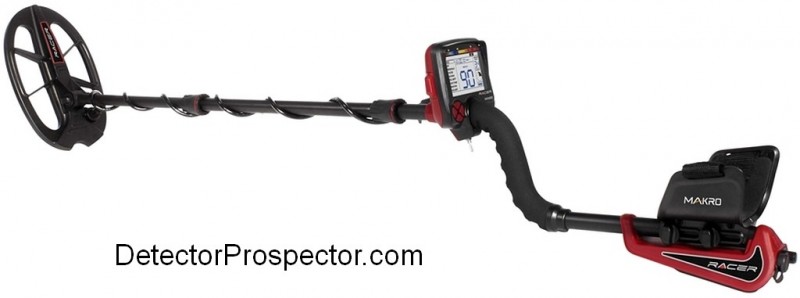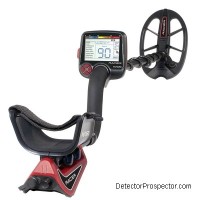
The Makro Racer metal detector was introduced in 2015 and discontinued in 2017, replaced by the Makro Racer 2. The Manufacturer Suggested Retail Price (MSRP) of $499 for the Racer was very aggressive for a detector that offers both manual ground balance and automatic ground tracking. The ergonomic three pound package drew attention, as did the Racer's ability to pull non-ferrous targets out of heavy trash.
The Makro Racer came standard with an 11" x 7" DD coil and had optional 5.5" x 4.7", 10" x 5.5", and 15.5" x 13.25" DD coils available. The Makro Racer models do not share coils with the Nokta FORS models. For those that are not aware of it, Makro and Nokta are under the same ownership and so there is considerable technology sharing between the two brands. The Makro Racer is a 14 kHz single frequency detector while the FORS models are 15 kHz and even though that is close, I have tested the coils and they are model specific.
The Makro Racer shares an almost identical feature set with the Nokta FORS CoRe metal detector and the Racer is basically a FORS CoRe in a lighter weight package and a forward facing display.
The Makro Racer includes innovative features like a handle incorporated vibration mode for use in very noisy areas. This feature can even be used to allow a deaf person to metal detect more efficiently and safely without having to constantly stare at the meter. There is a small LED flashlight built into the pod that illuminates the coil area in low light conditions.
The Makro Racer has a full set of accessory items available, including optional environmental cover set, a Bluetooth module and headphones, and coils including the new 10" x 5.5" DD coil. This coil will be the stock coil on the Gold Racer model. The Makro Racer comes with an 11" x 7" DD coil but a popular option will be the 10" x 5.5" DD coil. This is a superior coil for nugget detecting due to the narrower profile and solid design, which prevents it from snagging on brush or sharp edged rocks. Other coil options include the 5.2" x 4.7" DD coil and 15.5" x 13.25" coil. The small coil is great for hunting in really trashy locations and for finding the smallest targets. The large coil is mainly for covering more ground quickly but also adds extra depth on large items.
The Racer is a very high gain detector susceptible to overload signals. From Makro: "The electronic gain of the RACER consists of 3 levels to eliminate the internal electromagnetic noise and to adjust the saturation level. The electronic gain change points correspond to levels 39 and 69 on the Gain setting. In case of saturation (overload), you may raise your search coil a bit or adjust the Gain to the lower electronic gain level. For example, in the All Metal and Two Tone modes, if the Gain is set to 70 or above and if saturation occurs, adjusting the Gain to 69 or 39 will minimize or eliminate the saturation. Similarly, if you experience saturation in the Three Tone mode, adjusting the Gain to 39 will be sufficient. Reducing the gain will not cause a dramatic decrease in depth."
The target id chart below is based on statements by company representatives that the Racer is very similar to the Nokta FORS CoRe in capability combined with the target id reference label published in early photos. You can see below that the target id values on the reference label and those published in the FORS CoRe owners manual match almost perfectly.
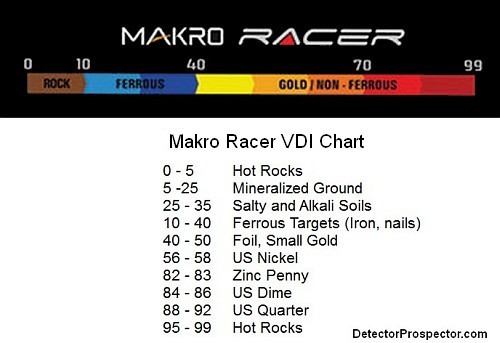
Makro Racer Target ID Chart
Makro is fast gaining attention as a company that listens to its customers. The new Makro Racer models are offering performance on par with detectors selling for quite a bit more money. They are simpler detectors focused on the task at hand - making good finds.
I had the experience of reading other reviews of the Makro Racer on the internet before using one myself. It highlighted for me that how I look at detectors and how they work for me is often remarkably different than what others experience. Depth tests in particular from back east have nearly no connection to what is see in the soil I hunt in. And air tests as usual show one thing and the ground another.
I have to preface this by noting that when I did this review in 2015 I was really waiting for the Makro Gold Racer. The Gold Racer has since been released but some of the commentary here is from before it came out.
The Racer offers the physical aspects I am looking for but the Gold Racer is tweaked specifically for gold, and gold is my thing! Some of what follows is just speculation on my part based on both models being Racer models and so therefore likely to share the same basic physical design. Whether the color will be the same, what the frequency will be, and even if they can share coils I do not know at this time. Still, here is a picture of what the Gold Racer will probably look like, except possibly the color.

Makro Racer with Optional 5.5" x 10" DD Coil
The bottom line I am pleased with the Makro Racer. I think people are just getting a little crazy with all the expectations it is supposed to replace detectors costing up to twice as much. This is a feature packed 14 kHz single frequency metal detector for $649 (later reduced to $499), nothing more and nothing less. It offers good performance for that price range and a feature set unmatched at that price. What I am looking at is a detector hot on gold with ground grab, manual ground balance, automatic ground tracking, good coil selection, at 3 lbs for $649.
Unfortunately the machine caught me at a bad time between two business trips and so I have only been able to give it a spin hunting a sandy tot lot and some general park detecting, both in highly mineralized ground. The ground runs 7/8 on the cool Makro pie chart which would be 5 bars on the Fisher F75. I rigged the Racer up with the optional 5.5" x 10" DD coil just to get a total unit weight with batteries as seen in the picture above. Three pounds, 1.5 ounces. Very nice! The coil is not an epoxy filled coil making for a much better weight and balance than for instance the Fisher Gold Bug Pro with similar size coil. The Fisher coil is epoxy filled and weighs in at 1 lb 2.6 oz whereas the Makro coil weighs 12.8 ounces. That is a fairly significant weight difference out there on the end of the rod.
ads by Amazon...
Still, I really like the little 4.2" x 5.5" DD coil and with that coil the Racer only weighs 2 lbs 15.7 ounces. The rod assembly is very tight and stout feeling. The hand grip, despite what others reported, works just fine for me. The angle changes if held high to give my thumb instant access to the four way control buttons. I am happy with the grip showing how it is very much a personal preference area. The Racer suits me because I have always imagined this as the "small coil" detector and the sister company Nokta FORS Gold as the "big coil" detector due to weight and balance design differences.
I found the depth and sensitivity of the 14 kHz Racer to be nearly identical to the 15 kHz FORS Gold, which is exactly what I was hoping for. I am talking about real world in highly mineralized ground. The perceived difference between the DI2 and DI3 modes all but disappears in bad ground.
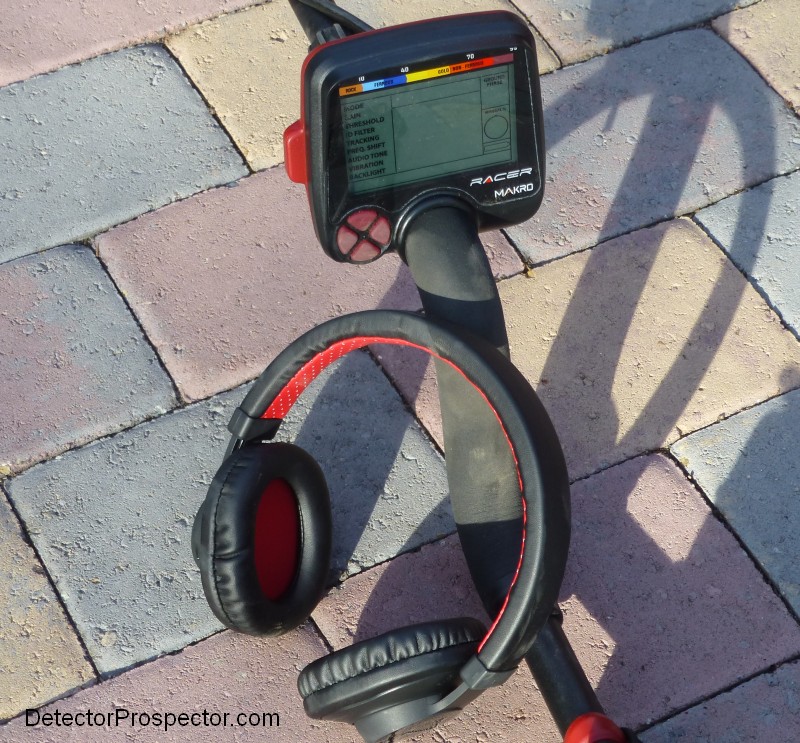
Makro Racer with Optional Bluetooth Module Installed and Wireless Headphones
I ran the wireless Bluetooth headphones and any lag or delay there is so minimal as to be almost unnoticeable to me. I certainly had no problem with it at all and quickly liked the wireless headphones from an operational standpoint. My only issue there is the audio quality compared to my Sun Ray Pro Golds is lacking. The Phillips phones have a muffled sound, the Sun Ray a much sharper, brighter tone. Not surprising given the relative price difference. Since we are talking Bluetooth I would like to haul the Racer to an audio store and try different headphones to find something of higher audio quality and with individual volume controls. I am a bit deaf in my right ear, another reason I like my Sun Rays with their dual volume controls. Bottom line is I found the lag issue to not be an issue for me personally but the audio quality is not what I am looking for in a headphone.
The Makro Racer is a very high gain detector, with important jumps in the gain occurring at two different locations on the sensitivity control. This note from Makro:
"The electronic gain of the RACER consists of 3 levels to eliminate the internal electromagnetic noise and to adjust the saturation level. The electronic gain change points correspond to levels 39 and 69 on the Gain setting. In case of saturation (overload), you may raise your search coil a bit or adjust the Gain to the lower electronic gain level. For example, in the All Metal and Two Tone modes, if the Gain is set to 70 or above and if saturation occurs, adjusting the Gain to 69 or 39 will minimize or eliminate the saturation. Similarly, if you experience saturation in the Three Tone mode, adjusting the Gain to 39 will be sufficient. Reducing the gain will not cause a dramatic decrease in depth."
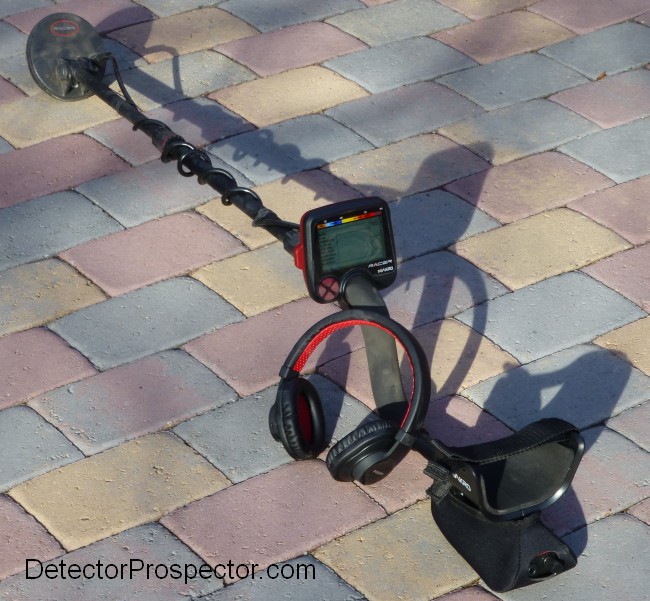
Makro Racer with 4.5" x 5" coil and wireless headphones
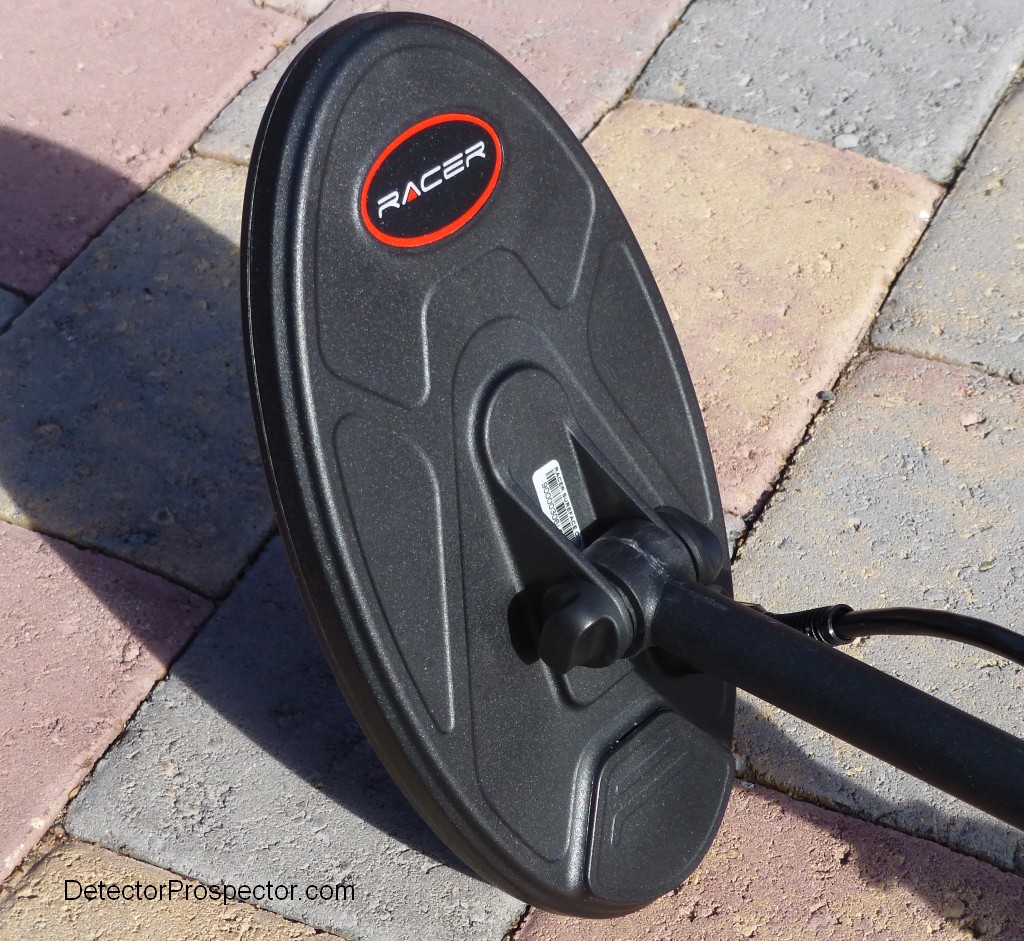
Close up of Makro racer optional 5.5" x 10" DD coil
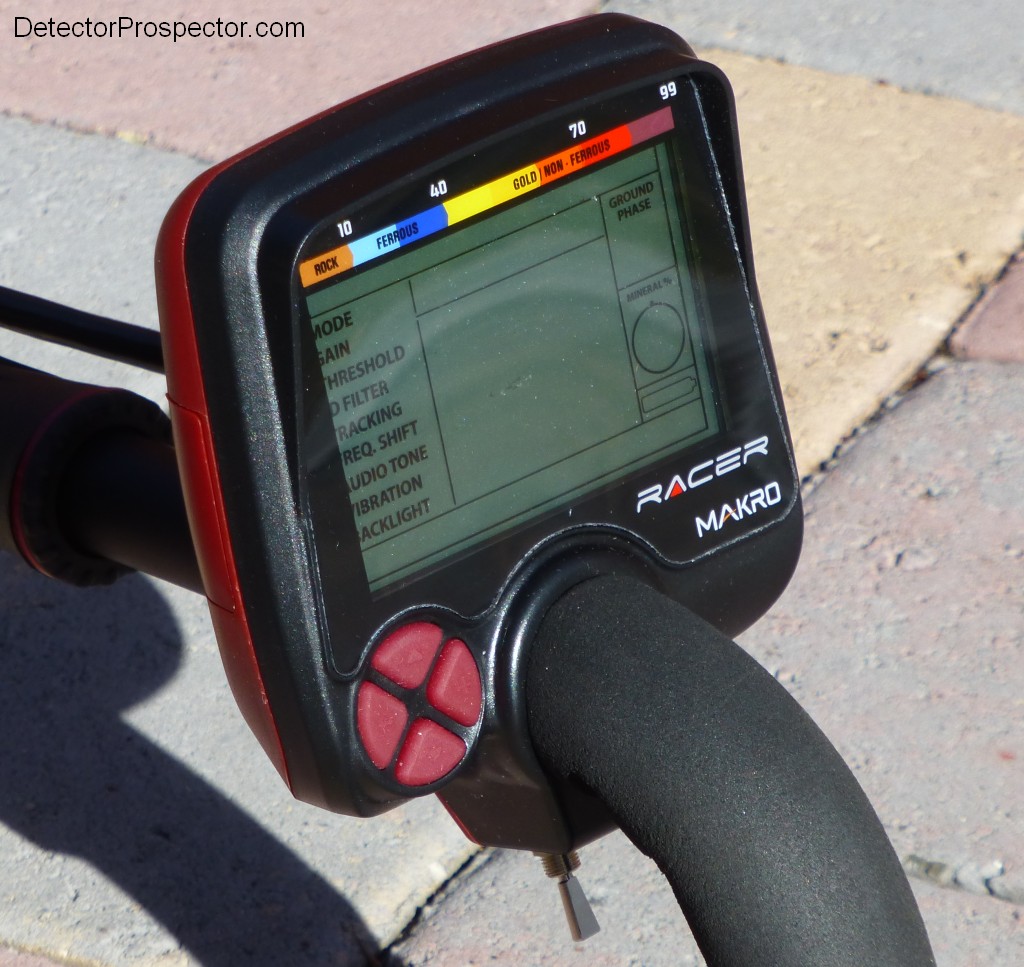
Close up of Makro Racer LCD display and controls
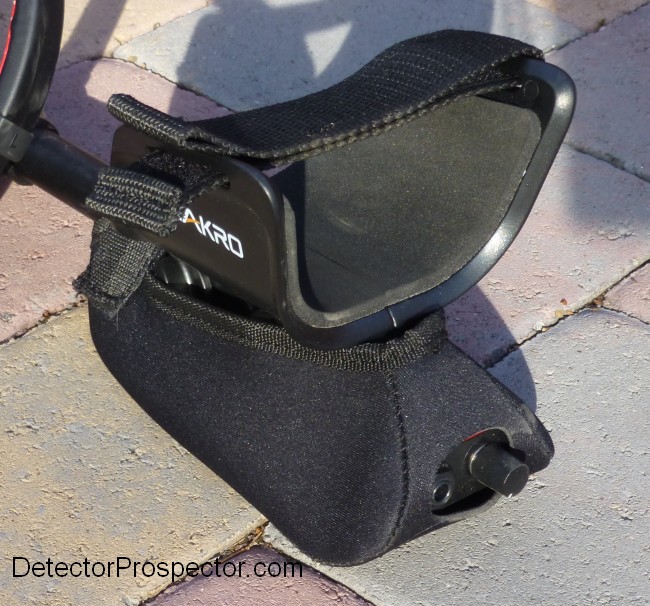
Close up of Makro Racer under arm battery compartment with protective cover, power/volume knob
My favorite feature? Quick mode switching. I was able to set up separate sensitivity levels for all metal, DI2, and DI3 modes and hunt with any one and switch rapidly between modes with the touch of a button. I only played with this a bit but immediately liked it. I found switching to all metal made for a better pinpoint mode than the pinpoint mode. Or I could hunt in all metal, then switch to two-tone ferrous mode to check the target. Switching between DI2 and DI3 is instant and effortless.
I like the big display, easy menu setup - bottom line I just like the detector. Just a great little machine, well thought out and with good performance at a good price. It fits me and my hunting style but again, it really is just a preview and a stepping stone to the Gold Racer. Chances are the Racer will be the model for those seeking slightly more versatility by way of the saltwater beach mode. The Gold Racer is likely to be too hot to play well with wet salt sand but that remains to be seen. So far so good though, I'm happy with where we are heading.
~ Steve Herschbach
Copyright © 2015 Herschbach Enterprises
June 2018 Note: The Makro Racer is now a part of history, but may still be found for sale used. Note that early models had a lot of issues with both coil ears and coil bolts breaking easily. The coils have been beefed up a lot since, but do look out for this if considering a used detector. Makro was great about taking care of that stuff under warranty, but these units are now out of warranty and you may have to take care of any such issues encountered with a used model on your own.
Makro Racer Instruction Manual
Forum Threads Tagged "makro racer"
| Internet Price | $499 |
| Technology | Induction Balance (IB) |
| Frequency | 14 kHz |
| Autotune Mode(s) | Pre-Set Slow Motion |
| Ground Rejection | Grab, Manual, & Tracking |
| Soil Adjust | No |
| Discrimination | Variable with Visual ID & Tone ID |
| Volume Control | Yes |
| Threshold Control | Yes |
| Tone Adjust | Yes |
| Audio Boost | No |
| Frequency Offset | Yes |
| Pinpoint Mode | Yes |
| Audio Output | 1/4" Headphone Socket & Speaker |
| Hip Mount | Shaft Mount Only |
| Standard Coil(s) | 11" x 7" DD |
| Optional Search Coils | 4.7" x 5.2" DD, 5.5" x 10" DD, 13.25" x 15.5" DD |
| Battery | Four AA |
| Operating Time | 25 - 30 hours |
| Weight | 3 lbs. |
| Additional Technology | Built in handle vibration target feedback, backlit screen, optional Bluetooth headphones |
| Notes | Discontinued in 2017 |
*Notes on Technical Specifications - Detailed notes about the specifications listed in this chart.


